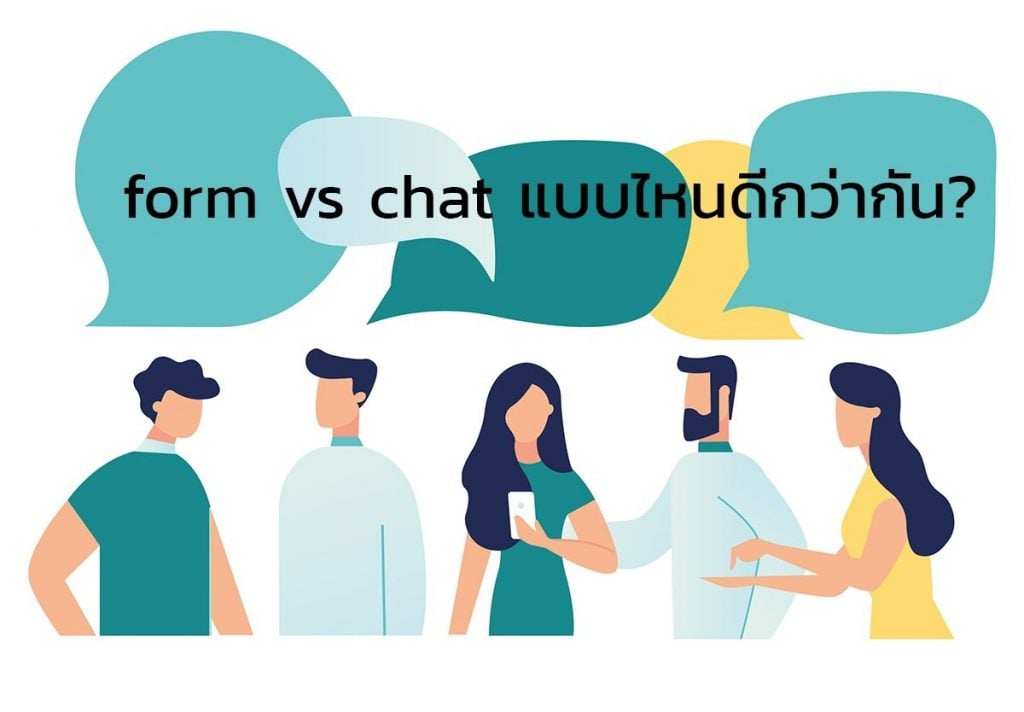Table of Contents
“No leads, no sales.”
If you are a marketer or have to deal with trading, you probably know or have heard this phrase: “No leads, no sales.” That means if there are no people interested in your product, then there is no chance of selling. The important thing is to start by changing the general public to become people interested in your product first. This will help increase the chance of closing the sale.
This is why it’s important to make an effort to drive more visitors to your website. This process involves weeding out the visitors who are most likely to be interested in your specific products or services, tools or expertise through your website. Then, if the opportunity arises, you can turn those visitors into leads in one of two ways.
- The “old” way – using a lead form
- The “new” way – by chatting with visitors on the website chat page
Form VS Chat: Which strategy creates more sales opportunities?
In any case, your strategy can affect your conversion rate, the number of people interested in your product, and the chances of making a sale. But do you know which of the above strategies gives the best results? You may not be able to give a clear answer, so to get a clearer picture, the Databox website conducted a survey to find information that is easier to understand by asking a group of entrepreneurs the following 2 questions:
Question 1: Which strategy will help you generate the best sales opportunities?
From the above illustration, we can see that the majority of entrepreneurs (around 50%) say that chatting directly with customers on their website increases their conversion rates the most.
Question 2: Where do you see the biggest increase in conversion rate, forms or chat responses?
One in three respondents (33%) still use form fill-in forms to convert viewers into leads, even though the increase in conversion rates is more noticeable from chat.
Why don’t you give up on the old ways?
Since converting visitors into leads, the survey concluded that chatting is the most likely way to close a sale, but form completion can also help generate leads.
Therefore, abandoning any one strategy may result in a loss of sales opportunities and a loss of customer base. To answer the question of why not just choose one thing, here is a summary of the information gathered from some entrepreneurs to help us see a wider perspective of knowledge.
What we will learn from the 3 strategy examples are:
- A group of entrepreneurs who use the “chat” method to talk directly with customers
- Group of entrepreneurs who use the “form filling” method
- A group of entrepreneurs who use both methods together
Chat: Interact face-to-face with real people in real time.
The pop-up message box at the bottom right corner is an attractive and curious sight. While you are thinking about something in your head, you hover your mouse over and click on the pop-up message box, which appears as a chat box.
“hello”
“I’m Mary. Is there anything I can help you with?”
The first thing you read after the message box is triggered is the greeting and question. You feel like you’re talking to a real person because of the blinking dots at the bottom as her message appears.
You put your hands on the keyboard, ready to accept the invitation.
“hello”
“Thank you very much. I just have a few questions that I would like to ask you.”
Web chat, whether it’s a real person responding or a virtual robot that makes you feel satisfied, is appealing. The advantage is the speed, which caters to people who are impatient and want to get answers as soon as they want. Of course, no one wants to wait for an answer for a long time, even over a day.
“There are psychological benefits to having direct chats with customers on your website. When people have questions, they can reach out to them as soon as they have them,” explains Antonella Pisana from EyeFul Media. “This strategy is very accessible to people, and chat communication can provide exactly what they expect.”
Here’s what other Databox respondents had to say about why they want to generate sales opportunities via chat.
“When possible, we prefer our customers to communicate with us via chat,” explains Ken Franzen of Neon Goldfish. “In the process of interacting with customers via chat, they see higher conversions. Real-time chat tools are often used in conjunction with form completion, rather than interchangeably.”
Ken Franzen’s group recently implemented a chat marketing strategy with a nursing school and saw a 110% increase in sales. The school plans to build a chatbot to answer common questions received via live chat.
The reason for using chat as a tool to communicate with website visitors is to provide instant gratification. These people often do not want to pick up the phone or call anyone at that time. It also helps to prevent the salesperson from suddenly attacking you. By using a chat tool to interact with your visitors, you can get answers immediately without feeling threatened by the salesperson. It feels like you are in control of the conversation.
Unlike talking on the phone, where it can be frustrating for customers to hang up right away, with chat, when they don’t want to continue the conversation, stepping away from the screen doesn’t feel awkward or inconvenient. Website visitors understand this, and chat provides a sense of ease in which they can decide to either continue the conversation or end it.
Remington Begg of Impulse Creative says the magic happened after he started using chat marketing on a platform called Drift, which resulted in 1.5x more sales opportunities than form fills alone. But he didn’t abandon the old-school approach, which still does what it’s supposed to do. Using the two strategies together has seen a 2.5x increase in conversions.
“Chatbots work better than filling out forms because our business model is to inspect the damage to the home,” says Vince Lefton of Bulldog Adjusters. “With chat, homeowners can ask questions in the moment and get them answered as quickly as they would on the phone. The form part is still nice, but chatbots have many advantages over traditional methods.”
David Olson of HelpOnClick agrees, saying, “Live chat allows for more sales opportunities than traditional forms on your website. Visitors who visit are more likely to convert to customers because they get real-time answers to their questions. In fact, more than 90% of inquiries come from chat, while the remaining 10% come from forms.”
Form Filling: Plain Old Marketing
Filling out a standard form where you fill in your first and last name, email, the company you work for and a subject line, which takes about 8 minutes to fill out and put in a document explaining why you want to contact us.
“I want a sample.” This is the topic you want. Then press the “Submit” button and you’re done.
Therefore, the form format is something that everyone knows and understands. General forms have the same standards for contact. Sometimes people choose to fill out forms instead of interacting via chatboxes.
“Filling in forms helps generate more sales opportunities on my website,” explains Maristellas Colombo of eBooks4Fashion. “Customers love free downloads, such as PDFs, videos, or samples.”
Here are some of the entrepreneurs explaining why they still use forms for marketing and prefer them.
“ After someone uses a form and it gets submitted, it’s a huge engagement,” explains Chili Piper’s Gaines Murfee. “While chat can work well, I find that the chat is just a question or two away.
Sometimes you don’t get the information from the customer, and it’s not a good idea to show it while you’re answering a question. Also, if you’re not paying attention to the customer, interrupting them can be distracting.”
“At Codal, we generate more qualified leads through our own website forms than through our chatbot,” says Ryan Bloms of Codal. “We’ve seen an increase in messages after using Drift’s chat platform, where people are often pitching us their ideas instead of asking questions about our services. When people spend time filling out website forms, they’re more likely to want to help us.”
“I spend a lot of time each day answering forms that fit my workflow. For example, sometimes people who message me through chatbots just say ‘hi.’ These people aren’t interested in the product, they’re just people who have passed by and gone. I want to spend more time searching for interesting information than just the data on the forms.”
Two strategies together, why can’t it be impossible?
If instant Q&A chat and the familiar form filling are both equally convenient, then why not use them together?
Why not let website visitors choose for themselves what they are more familiar with, letting them choose what they are most comfortable communicating with us entrepreneurs?
Jonathan Aufray of Growth Hackers explains that it’s a tough question to answer as to which strategy is better, or which one you should use, because the right answer really depends on your industry, your marketing, and your target audience. In some cases, we find that using a form field is better than a chat box, but other times, a chat box just works. There’s no set rule.
As Ally Compeau of Woof Signs tells us, you may be attracting different potential buyers. If you look closely, you’ll notice that the chat function on your website works wonders. If a customer wants a quick answer, which often involves pitching us your product, once they’ve got what they need, they’ll take advantage of filling out a form to get a quote. This is an audience with purchasing power and is ready to pay.
Our advice
While we are often led to believe that form-based marketing is dead and chat-based marketing is taking over, we know that every industry has different rules and no two audiences will necessarily have the same needs. So try to track the metrics in your system, and choose a system you trust based on what you see in your tracking process.
This mindset can help your business succeed and convert visitors into customers without having to conclude that it has to be a form-based platform or a website chat. It all depends on many variables that you as an entrepreneur will need to understand and find the right marketing for your business.





